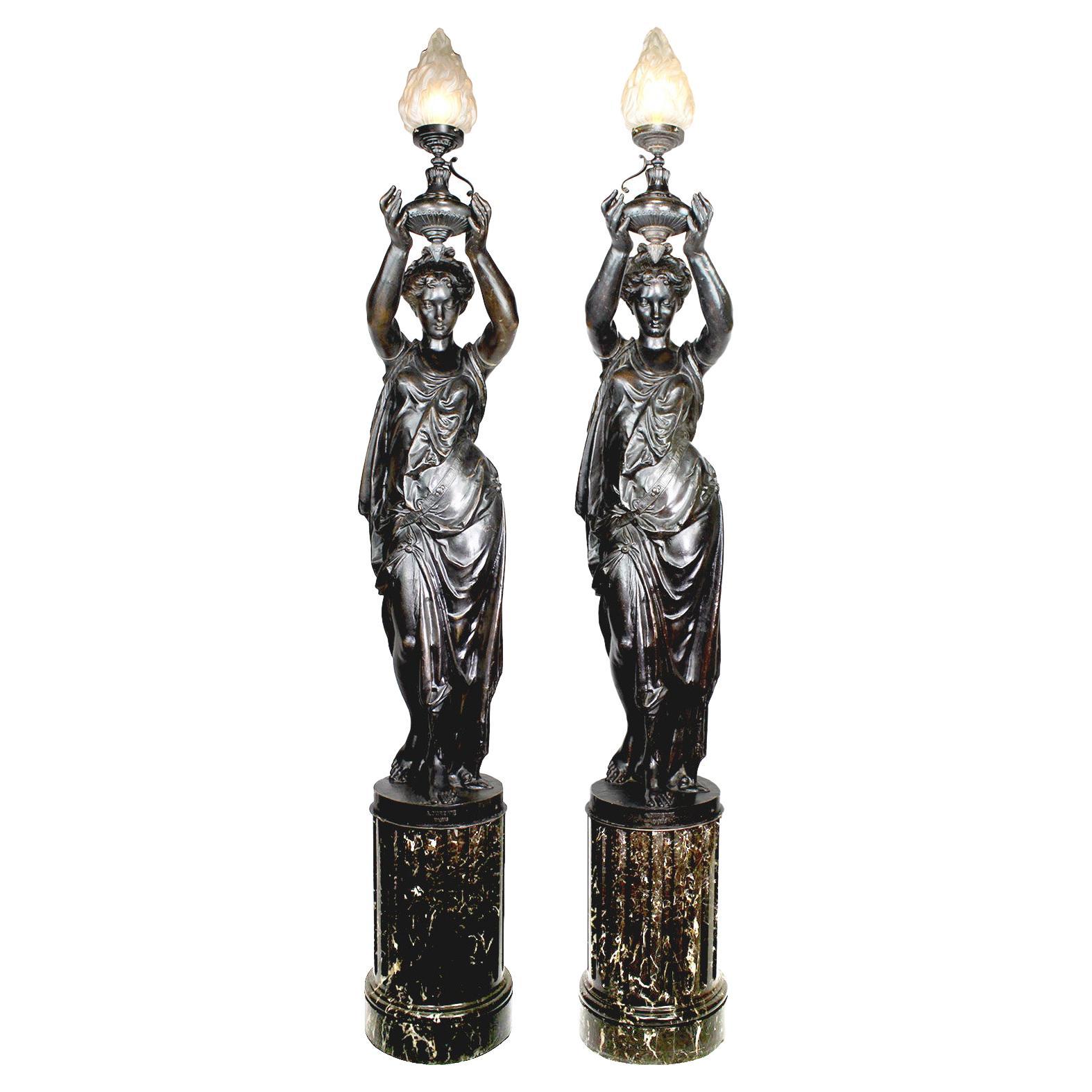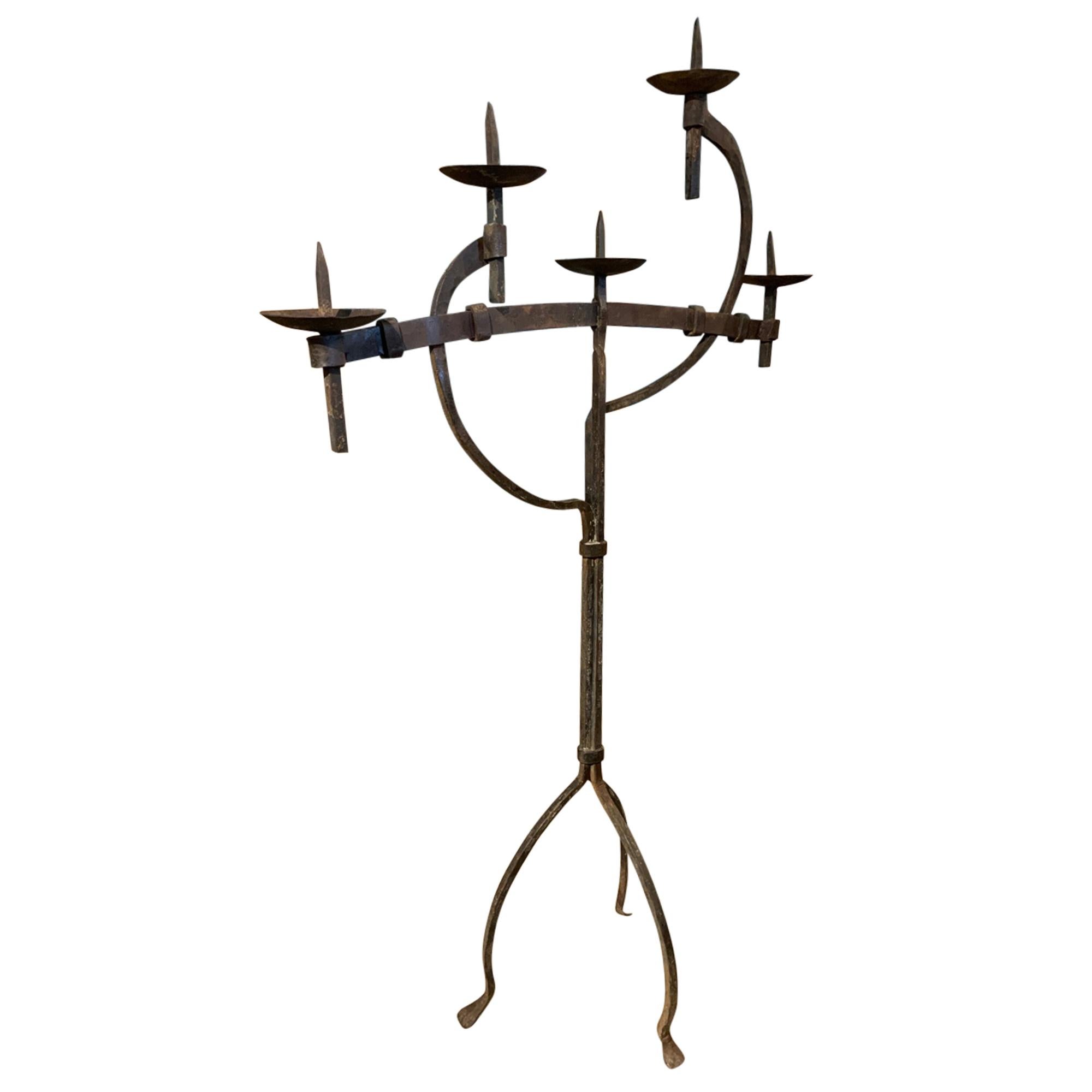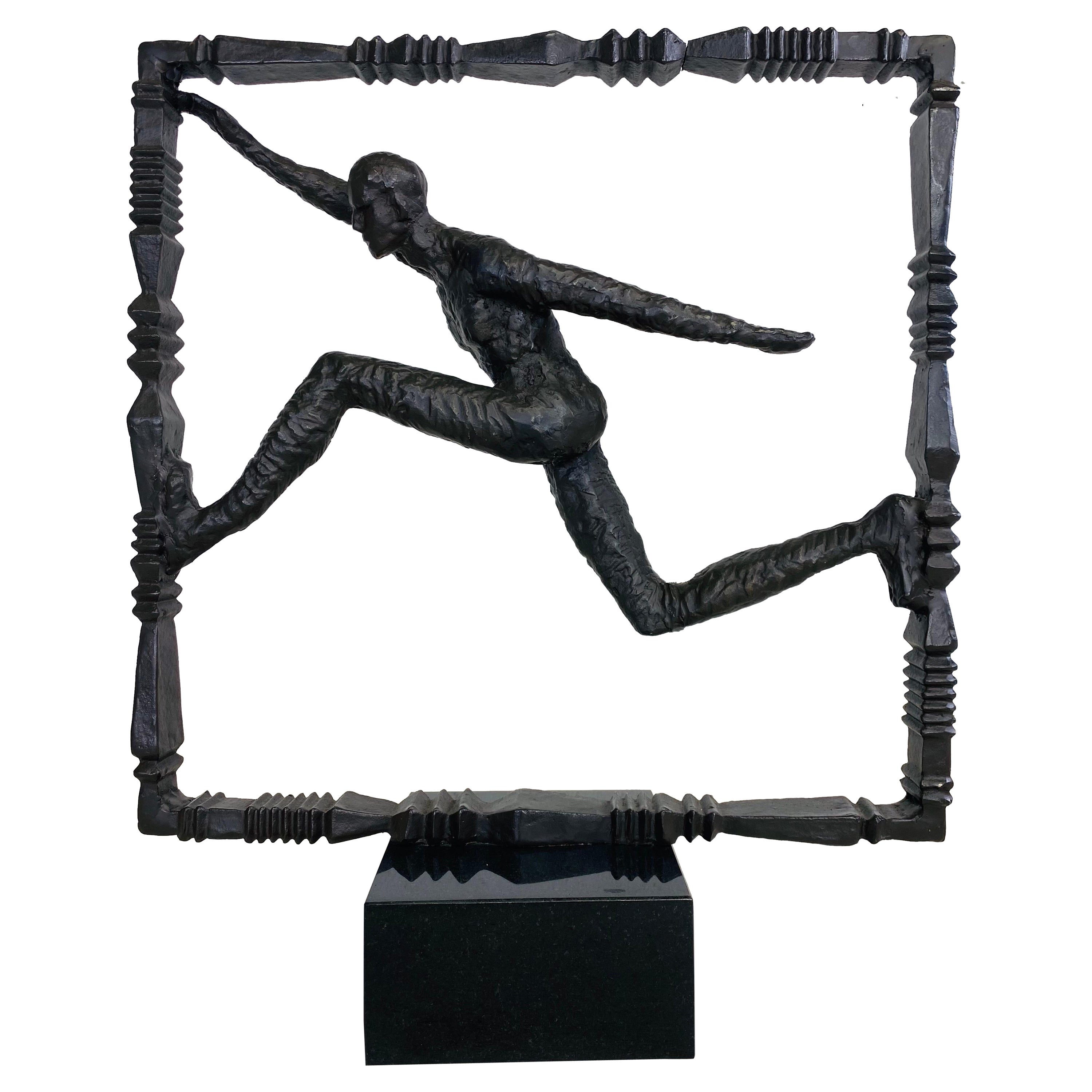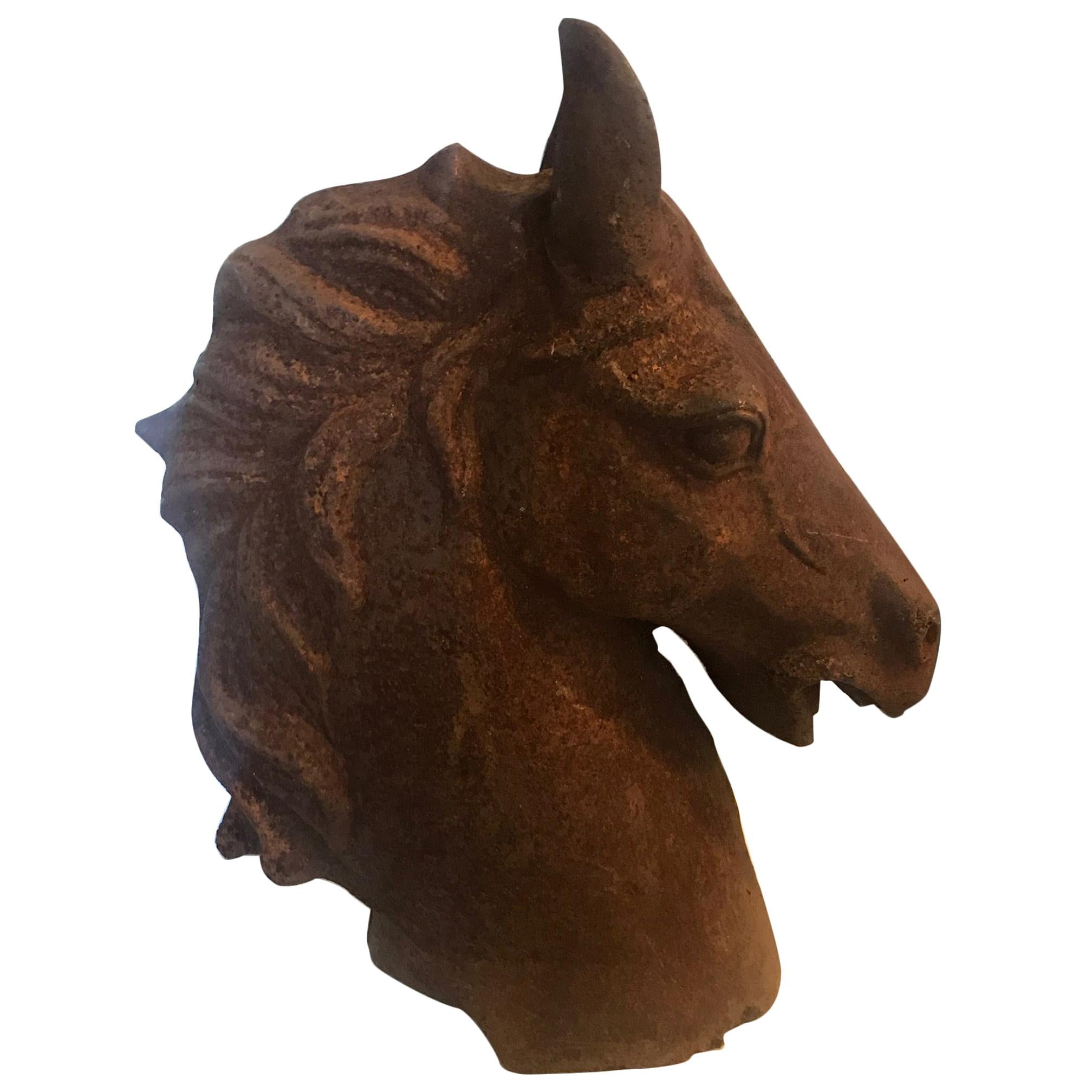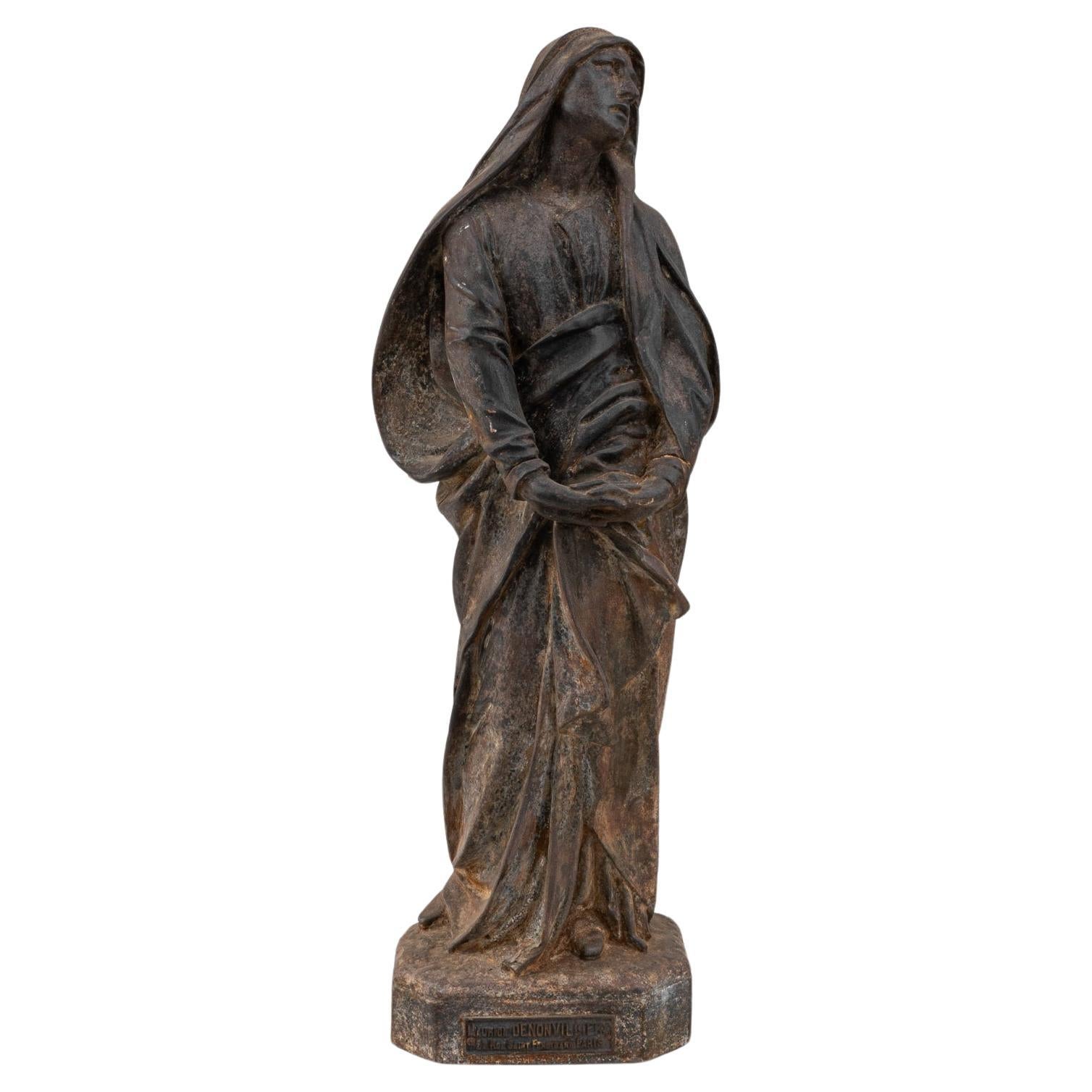Items Similar to Palatial French 19th-20th Century Allegorical Figural Cast Iron Group Torchere
Want more images or videos?
Request additional images or videos from the seller
1 of 9
Palatial French 19th-20th Century Allegorical Figural Cast Iron Group Torchere
About the Item
A very fine and palatial French 19th-20th century allegorical figural cast-iron group torchere - sculpture - fountain - representing spring and the harvest, probably cast by Le Fonderies d'Art du Val d'Osne. The charming four-putti sculpture with a front standing putto holding a pole amongst wheat stalks, another putto kneeling and collecting wheat, a third one wearing a hat and picking flowers for a wreath and the fourth kneeling putto holding a bird's nest, all below an elongated classical stem with a glass globe (Electrified), circa: Paris, 1900.
Overall height: 84 inches (213.4 cm).
Width: 29 1/2 inches (74.9 cm).
Circular base diameter: 24 inches (61 inches).
Cast-iron had been in production during the 18th century but its inferior status to the more fashionable and delicate wrought-iron had generally confined its use to architectural work. By the early 19th century, however, rapid developments of the Industrial Revolution combined with the simultaneous burgeoning of a new middle class provided the impetus for a dramatic expansion in its application and in a short space of time a proliferation of iron foundries across Europe and America thrived on the production of everything from inkstands to railway stations. The use of cast-iron for garden ornament became particularly widespread at this time, as the possibilities for its mass-production at a fraction of the cost of bronze made it the material of choice for outdoor statuary, figural lighting, fountains and vases. Nowhere was the popularity and use of cast-iron ornament greater than in France, where by the second half of the 19th century two foundries in particular, which feature prominently in the following collection, had come to dominate production both for the home market and for export. The more important of these was the officially named Société Anonyme des Hauts-Fourneaux et Fonderies du Val-D'Osne, Anciennes maisons J. P. V. André et J. J. Ducel et Fils. Commonly known after 1870 as simply Val D'Osne, the company was originally founded in 1835 and developed rapidly, absorbing smaller foundries in the Haute-Marne area east of Paris. Smaller than Val D'Osne but nevertheless a major player in the manufacture of cast-iron was the firm of A. A. Durenne, established in 1847 at Sommevoire. Both Val D'Osne and Durenne were frequently awarded medals for their work at the many international exhibitions of the latter half of the 19th century. Each also published large catalogues illustrating and listing its entire inventory of models, from which casts of varying size and finish could be ordered.
Fonderies d'Art du Val d'Osne.
Established in 1835 by J.P.V. André, the Fonderies d'Art du Val d'Osne was known for their high quality and extensive collection of cast-iron architectural designed sculptures created exclusively for Victor André by some of the most reputed and established Parisian sculptors like Carrier-Belleuse, Mathurin Moreau, Delaplanche and Pradier. The prolific firm Fonderies d'Art du Val d'Osne participated in numerous international exhibitions and was acclaimed at the 1857 London Exhibition with a monumental bronze fountain cast with swans and Classical figures. The firm was acquired by Barbezat & Cie. in 1867, and allying with the fondeur J.J. Ducel towards 1870, and was renamed Société Anonyme des Hauts-Fourneaux & Fonderies du Val-D'Osne, Anciennes maison J.P.V. André et J.J. Ducel et Fils. The most celebrated work or art cast by the firm would be irrefutably the Parisian subway entrances designed by Hector Guimard. The firm was also known for their comissions by governments to manufacture sculptures and fountains for display at public parks and buildings in major cities around the world.
Literature:
Société Anonyme des Hauts-Fourneaux & Fonderies du Val-D'Osne catalogue.
- Attributed to:Val D'Osne Foundry (Metalworker)
- Dimensions:Height: 84 in (213.36 cm)Width: 29.5 in (74.93 cm)Depth: 29.5 in (74.93 cm)
- Style:Rococo (In the Style Of)
- Materials and Techniques:
- Place of Origin:
- Period:1900-1909
- Date of Manufacture:circa 1900
- Condition:Wear consistent with age and use. Minor fading. Overall condition is very good, a very charming sculpture. Patina refreshed. Wired for electricity.
- Seller Location:Los Angeles, CA
- Reference Number:
About the Seller
5.0
Vetted Seller
These experienced sellers undergo a comprehensive evaluation by our team of in-house experts.
Established in 1982
1stDibs seller since 2016
114 sales on 1stDibs
Typical response time: <1 hour
- ShippingRetrieving quote...Ships From: Los Angeles, CA
- Return PolicyThis item cannot be returned.
More From This SellerView All
- Pair of French 19th-20th Century Neoclassical Style Cast Iron Figural TorchèresLocated in Los Angeles, CAA very fine pair of French 19th-20th century neoclassical style patinated cast iron figural torchères by A. Durenne, Paris, each representing a figure of a standing young maiden, her arms raised forward while holding a a flaming urn gas light (Now electrified) with a frosted glass flame, each raised on a veined grey marble column stand, both cast-signed 'A. Durenne, Paris'. Antoine Durenne was an internationally renowned French art founder. He attended École Nationale Supérieure des Beaux-Arts in 1842. Durenne purchased a small foundry in Sommevoire, near the Val d'Osne, Haute-Marne, France and established The Durenne firm, circa Paris, 1900. Cast-iron had been in production during the 18th century but its inferior status to the more fashionable and delicate wrought iron had generally confined its use to architectural work. By the early 19th century, however, rapid developments of the Industrial Revolution combined with the simultaneous burgeoning of a new middle class provided the impetus for a dramatic Expansion in its application and in a short space of time a proliferation of iron foundries across Europe and America thrived on the production of everything from inkstands to railway stations. The use of cast-iron for garden ornament became particularly widespread at this time, as the possibilities for its mass-production at a fraction of the cost of bronze made it the material of choice for outdoor statuary...Category
Antique Early 1900s French Neoclassical Revival Figurative Sculptures
MaterialsMarble, Iron
- Pair of French 19th Century Lifesize Cast-Iron Sculpture Torcheres, Val d'OsneBy Val D'Osne FoundryLocated in Los Angeles, CAA superb quality and palatial pair of French 19th century lifesize cast-iron sculptures - torcheres of Native American Indians titled "L’ Indienne" designed by Jules Salmson (French, 1823-1902) and Cast by Le Fonderies d'Art du Val d'Osne, each standing figure representing a Native American Indian male and a female scantily dressed in their native robes, one arm raised holding a light-torch with an opaline glass globe, both wearing earrings, seashell necklaces and arm-braces, raised on cylindrical cast-iron stand. Signed/cast on each pedestal: “VAL D’OSNE”. (Electrified). Paris, circa 1870-1880. Overall hHeight: 127 inches (322.6 cm) Pedestal height: 39 inches (99.1 cm) Indian man's width: 22 inches (55.9 cm) Indian man's depth: 26 3/4 inches (68 cm) Indian woman's width: 28 inches (71.1 cm) Indian woman's depth: 25 inches (63.5 cm) These fantastic and impressive pair of cast-iron sculptures, most likely representing Hiawatha and Minnehaha, were probably comissioned to Le Fonderies d'Art du Val d'Osne for export to the America's to decorate governmental buildings and parks which makes these pair a rare find and now available for a private collection. Iron sculptures were preferred over bronze for outdoor park and building decorations for their long lasting resistance to all types of weather conditions. An identical pair of sculptures, also by Val d' Osne, are currently exhibited at the National Garden of Congress in Santiago, Chile. View Pages No. 87, 88, 89. Another identical pair are also currently exhibited at The Musée de la Ville - Indian Museum "O Indio do Museo da Cidade" in Rio de Janeiro, Brazil. Another identical pair decorate the front of the Ópera Teatro Amazonas, Manaús, Brazil. A single figure of the female Indian...Category
Antique 19th Century French Tribal Figurative Sculptures
MaterialsIron
- A Life-Size Pair French Cast-Iron Torchères Sculptures Juggler & Serpent CharmerBy Val D'Osne FoundryLocated in Los Angeles, CAA Palatial Life-Size Pair of French 19th-20th Century Cast-Iron Torchères Sculpures figures of "Jongleur and Charmeur de Serpents" (Juggler and Snake-Charmer) After the model by Mathurin Moreau (French, 1822-1912), attributed to Le Societe Anonyme des Hauts-Fourneaux et Fonderies du Val D'Osne - 58 Boulevard Voltaire, Paris. The monumental pair of indoor or outdoor torchère lights, each torchère portrays a standing half-clothed black male engaging in traditional entertainment activities reflecting the cultural practices of the 19th century and early 20th century, one as a juggler and the other one as a snake charmer. The skill and cultural context of these impressive pair of sculptures add depth and charm highlighting the artistic technics, and the emotions being conveyed by each figure. The present pair of torchere are based on the engravings of Statues published by the celebrated sculptor, Mathurin Moreau (d. 1912). As their trade catalogues reveal, Moreau's oeuvre was extensively reproduced by the Val d'Osne foundry during the latter quarter of the 19th century (see photos of the Val d'Osne original catalogue). Established in 1835 by André, Val d'Osne was subsequently renamed Houille et Cie. in 1867 when taken over by Barbezat. By 1870, however, it was known as the Société Anonyme des Hautes Fourneaux & Fonderies du Val d'Osne, exhibiting its wares in a Paris showroom at Boulevard Voltaire. Unsigned. (Electrified). Circa: Paris, 1890-1900. Fonderies d'Art du Val d'Osne Established in 1835 by J.P.V. André, the Fonderies d'Art du Val d'Osne was known for their high quality and extensive collection of cast-iron architectural designed sculptures created exclusively for Victor André by some of the most reputed and established Parisian sculptors like Carrier-Belleuse, Mathurin Moreau, Delaplanche and Pradier. The prolific firm Fonderies d'Art du Val d'Osne participated in numerous international exhibitions and was acclaimed at the 1857 London Exhibition with a monumental bronze fountain cast with swans and Classical figures. The firm was acquired by Barbezat & Cie. in 1867, and allying with the fondeur J.J. Ducel towards 1870, and was renamed Société Anonyme des Hauts-Fourneaux & Fonderies du Val-D'Osne, Anciennes maison J.P.V. André et J.J. Ducel et Fils...Category
Antique Early 1900s French Moorish Figurative Sculptures
MaterialsIron
- Monumental Pair of French 19th-20th Century Putto Flambeaux Urns TorcheresBy René Rozet 1Located in Los Angeles, CAMonumental pair of French 19th century figural gilt and patinated bronze Rosso Granite marble Flambeaux Urns Torcheres, each depicting a pair of allegorical Putti (Children) holding ...Category
Antique 1890s French Louis XV Figurative Sculptures
MaterialsGranite, Bronze
- Large French 19th Century Cast-Iron Fountain Figure of a Seated Nude MaidenBy J.J. Ducel Me de Forges 1Located in Los Angeles, CAA Fine and Large French 19th Century Cast-Iron Fountain Figure Modeled as a Nude Maiden Seated on a Rocky Outcrop Holding a Cornucopia in Her Raised Right Hand, by J.J Ducel. Cast-Signed "J.J. DUCEL Me de FORGES, PARIS". Circa: Paris, 1880. A retailer of fine cast-iron ornaments, J. J. Ducel was recorded as supplying cast-iron works through Paris as early as 1810 in the Pas-de-Calais. The factory was sold in 1878 to the Fonderie de la Haute-Marne and all of the firm's models were subsequently bought by the Val d'Osne foundry. However, prior to the firm's sale, critics at the 1867 Paris Exposition Universelle proclaimed that "Ducel is the great manufacturer of works in cast-iron, to whom Paris is so largely indebted for the grace and elegance that supply so many of the adornments of its streets". Ducel, Val d'Osne and other associated foundries produced both bronze and cast-iron statuary. Cast-iron is corrosive, whereas non-ferrous bronze does not suffer the same detrimental effects of weathering and is therefore a superior and more expensive material. Height: 51 1/2 inches (130.8 cm) Width: 22 inches (55.9 cm) Depth: 30 inches (76.2 cm) The foundry of Val d'Osne became highly regarded for the varied nature and quality of its castings in the second half of the 19th century. Commonly known after 1870 as simply Val D'Osne, the company was originally founded by J.P.V. André in Val d'Osne 1835 and developed rapidly, absorbing smaller foundries in the Haute-Marne area east of Paris. The foundry contributed to the London International Exhibition of 1851, where a bronze fountain cast with classical figures attracted much attention. André also specialised in fancy castings and architectural fittings. His Paris adress was at 14 Rue Neuve, Menilmontant. In 1855 the Barbezat & Cie Foundry was born out of the André workshop. In 1867 Barbezat & Cie changed its name to Houille & Cie. Then, in 1870, it changed its name to Société Anonyme du Val d'Osne. With the change of name came the change of casting mark and adress: Fonderies d'Art du Val d'Osne, 58 Bd Voltaire, Paris or simply Val d'Osne. Cast-iron had been in production during the 18th century but its inferior status to the more fashionable and delicate wrought-iron had generally confined its use to architectural work. By the early 19th century, however, rapid developments of the Industrial Revolution combined with the simultaneous burgeoning of a new middle class provided the impetus for a dramatic expansion in its application and in a short space of time a proliferation of iron foundries across Europe and America thrived on the production of everything from inkstands to railway stations. The use of cast-iron for garden ornament became particularly widespread at this time, as the possibilities for its mass-production at a fraction of the cost of bronze made it the material of choice for indoor/outdoor statuary...Category
Antique 19th Century French Classical Greek Figurative Sculptures
MaterialsIron
- French, 19th Century Versailles Style Figural Torchère with Side-by-Side PuttiBy Lacarrière, Delatour and Co.Located in Los Angeles, CAA very fine and large Museum Quality french, 19th century Versailles Style Figural Torchère with two side-by-side Putti in a Brown and Parcel-Gilt Patina Holding a Four-Light gilt bronze Candelabrum with Frosted glass flame shades, by Lacarrière Delatour...Category
Antique 19th Century French Louis XV Figurative Sculptures
MaterialsBronze
You May Also Like
- French 19th Century TorchèreLocated in Atlanta, GAA very intriguing later 19th century French torchère - Standing candelabra - in expertly hand forged iron. A beautiful art piece.Category
Antique 19th Century French Floor Lamps
MaterialsIron
- Late 20th Century Cast Iron Modernist, Figural SculptureBy G. NoneLocated in Allentown, PAThis is a vintage late 20th century cast iron figurative sculpture. The sculpture is in black cast iron and has an abstract quality. This dynamic impressionist male form is encased i...Category
1990s American Mid-Century Modern Figurative Sculptures
MaterialsIron
- 20th Century French Cast Iron Horse HeadLocated in LEGNY, FRBeautiful 20th century French cast iron Horse head from the 1980s. Nice quality and condition. Ideal in a garden as an ornament.Category
Vintage 1980s French Animal Sculptures
MaterialsMetal
- 19th Century French Cast Iron SculptureLocated in High Point, NCThis evocative 19th Century French Cast Iron Sculpture captures the profound emotion and exquisite detail synonymous with the era's artistry. The figure, robed in beautifully sculpte...Category
Antique 19th Century French Figurative Sculptures
MaterialsIron
- 19th Century French Cast Iron SculptureLocated in High Point, NCThis 19th Century French Cast Iron Sculpture exudes the spirit of the Romantic era with its evocative depiction of a pensive figure. The artistry of the sculpture is evident in the e...Category
Antique 19th Century French Figurative Sculptures
MaterialsIron
- 19th Century French Cast Iron SculptureLocated in High Point, NCBehold the stately elegance of this 19th Century French Cast Iron Sculpture, a stunning representation of classic beauty and enduring craftsmanship. The sculpture, with its weathered...Category
Antique 19th Century French Figurative Sculptures
MaterialsIron
Recently Viewed
View AllMore Ways To Browse
Cast Iron Lighting
Figural Lighting
Antique French Furniture London
French Antique Furniture London
Early 20th Century American Lighting
Antique Home Lighting
European 19th Century Lighting
French Iron Flower
Black Cast Iron Lighting
Antique Lighting Collections
Antique Industrial Lighting 20th Century
Entrance Lighting
Industrial Cast Iron Base
Antique Lighting Company
Rococo Architecture
Antique Lighting Globes
Antique Cast Iron Lighting
Lighting Torcheres
